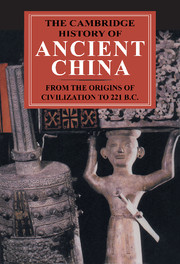Book contents
- Frontmatter
- Introduction
- 1 China on the Eve of the Historical Period
- 2 Language and Writing
- 3 Shang Archaeology
- 4 The Shang: China’s First Historical Dynasty
- 5 Western Zhou History
- 6 Western Zhou Archaeology
- 7 The Waning of the Bronze Age: Material Culture and Social Developments, 770–481 B.C.
- 8 The Spring and Autumn Period
- 9 Warring States Political History
- 10 The Art and Architecture of the Warring States Period
- 11 The Classical Philosophical Writings
- 12 Warring States Natural Philosophy and Occult Thought
- 13 The Northern Frontier in Pre–Imperial China
- 14 The Heritage Left to the Empires
- Bibliography
- Index
- Map 1 Topography of China
- Map 3.1 Archaeological sites of the Early Bronze Age
- Map 6.1 Archaeological sites of the Western Zhou period
- References
Introduction
Published online by Cambridge University Press: 28 March 2008
- Frontmatter
- Introduction
- 1 China on the Eve of the Historical Period
- 2 Language and Writing
- 3 Shang Archaeology
- 4 The Shang: China’s First Historical Dynasty
- 5 Western Zhou History
- 6 Western Zhou Archaeology
- 7 The Waning of the Bronze Age: Material Culture and Social Developments, 770–481 B.C.
- 8 The Spring and Autumn Period
- 9 Warring States Political History
- 10 The Art and Architecture of the Warring States Period
- 11 The Classical Philosophical Writings
- 12 Warring States Natural Philosophy and Occult Thought
- 13 The Northern Frontier in Pre–Imperial China
- 14 The Heritage Left to the Empires
- Bibliography
- Index
- Map 1 Topography of China
- Map 3.1 Archaeological sites of the Early Bronze Age
- Map 6.1 Archaeological sites of the Western Zhou period
- References
Summary
In their general introduction to the first volume of the Cambridge History of China (The Ch’in and Han Empires), John K. Fairbank and Denis Twitchett, general editors of the series, explained why, when they were planning the series in the 1960s, they had felt obliged to start their coverage with the first empires, omitting earlier developments. After noting the transformation brought about by archaeological discoveries, they wrote:
This flood of new information has changed our view of history repeatedly, and there is not yet any generally accepted synthesis of this new evidence and the traditional written record. In spite of repeated efforts to plan and produce a volume or volumes that would summarize the present state of our knowledge of early China, it has so far proved impossible to do so.
However, by the time that first volume was published (1986), some twenty years after Fairbank and Twitchett had initiated the Cambridge History of China project, the “flood of new information” that they mentioned had already revitalized the study of ancient China. A large number of scholars, both in East Asia and in the West, had been drawn to consider the new archaeological evidence and, in its light, to reconsider China’s traditional written record and many of the historiographical assumptions based there on. In the light of these developments in the field, and with the active encouragement of Denis Twitchett, Cambridge University Press determined to repair the omission, the result being the present Cambridge History of Ancient China.
- Type
- Chapter
- Information
- The Cambridge History of Ancient ChinaFrom the Origins of Civilization to 221 BC, pp. 1 - 36Publisher: Cambridge University PressPrint publication year: 1999
References
- 4
- Cited by

